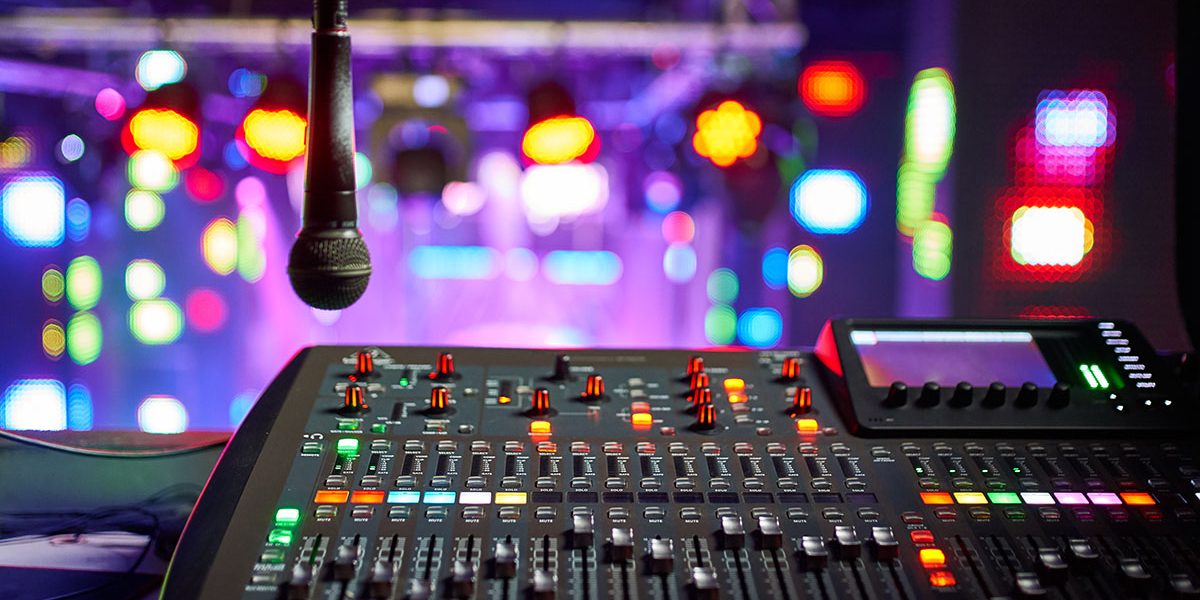The essential plan for planning events with audio visual charlotte nc
Wiki Article
Understanding the Incorporation of Audio Visual Technology in Today's Educational Environments
The integration of audio-visual technology in instructional setups has transformed the mentor and discovering process. Educators now have access to devices that cater to numerous learning styles, boosting trainee engagement and partnership. The consolidation of these technologies provides both opportunities and challenges. Comprehending how to properly carry out these devices is crucial. What methods can instructors utilize to optimize the benefits of audio-visual modern technology in their classrooms?The Advancement of Audio-Visual Innovation in Education
As instructional needs progressed over the years, audio-visual innovation undertook significant transformations that improved the knowing setting. Tools such as movie projectors and slide shows were the primary ways of integrating aesthetic components right into classrooms. These early innovations given educators with the capability to present details dynamically, yet they were restricted in availability and interactivity.With the advent of videotape recorder in the 1970s, class started to include recorded lessons, expanding the scope of academic resources. The introduction of computers in the 1980s more revolutionized this landscape, permitting the production of multimedia presentations and interactive learning experiences.
The rise of the internet in the 1990s noted a zero hour, making it possible for real-time accessibility to a riches of audio-visual materials. Today, digital devices such as interactive white boards and on the internet knowing platforms remain to boost the educational experience, fostering involvement and partnership among learners.
Advantages of Audio-Visual Tools for Diverse Learning Styles
Audio-visual devices play an important role in dealing with varied discovering styles by enhancing aesthetic discovering and enhancing auditory engagement. By including photos, video clips, and noise, these technologies develop an even more comprehensive academic setting. This multifaceted approach permits educators to resolve the different preferences and demands of students successfully.Enhancing Visual Learning
Involvement in the knowing process is significantly boosted with using audio-visual devices, dealing with different learning designs. These tools, such as video clips, infographics, and interactive presentations, give visual stimulations that help understanding and retention. Aesthetic students, particularly, advantage from the incorporation of pictures and computer animations, which can simplify complex principles and enhance understanding. Additionally, audio-visual resources can show real-world applications, making discovering more appropriate and interesting. By integrating color, activity, and sound, educators can develop a vibrant discovering setting that captures students' interest and fosters much deeper cognitive links. Ultimately, the calculated use audio-visual technology not only supports aesthetic understanding but likewise enriches the general instructional experience for diverse learners.Improving Auditory Engagement
A considerable benefit of including audio-visual devices in education is their ability to enhance auditory engagement among trainees. These tools, which incorporate multimedia presentations, podcasts, and interactive sound elements, deal with different finding out styles, especially profiting acoustic students (audio visual charlotte nc). By integrating audio and narration, teachers can create immersive experiences that record students' attention and reinforce comprehension. This interaction is necessary, as it fosters a much deeper understanding of the material and promotes retention. Furthermore, audio-visual devices can help with joint discovering atmospheres, motivating students to take part in conversations and share their insights. Ultimately, the unification of audio-visual modern technology not just supports auditory engagement however likewise enhances the overall instructional experience, making finding out a lot more dynamic and effective for all pupilsEnhancing Involvement With Interactive Knowing

Gamification components, such as tests and simulations, can improve inspiration and retention, making learning much more delightful and effective. These techniques not just stimulate cognitive interaction yet also satisfy varied discovering styles, making certain that all students can get involved meaningfully. Consequently, interactive understanding settings promote a feeling of area and belonging, inevitably leading to boosted academic outcomes. With the combination of audio aesthetic modern technology, educators can transform typical class right into dynamic areas where trainees grow and proactively form their educational trips.
Linking Concept and Practice With Multimedia Resources
Multimedia resources work as a crucial web link in between theoretical concepts and useful application in educational settings. By enhancing interaction, promoting joint learning experiences, and supporting diverse learning styles, these tools create a more comprehensive and vibrant learning setting - audio visual charlotte nc. This approach not only promotes deeper understanding yet additionally prepares pupils for real-world obstacles
Enhancing Engagement Through Multimedia
Involvement in academic setups substantially boosts when trainers incorporate multimedia sources into their teaching approaches. The usage of videos, podcasts, and interactive presentations boosts the discovering experience, allowing pupils to get in touch with the product on numerous levels. Multimedia sources satisfy go various discovering styles, providing aesthetic, auditory, and kinesthetic stimulations that can hold trainees' attention a lot more successfully than conventional lecture approaches. Furthermore, these resources can streamline complex ideas, making them more obtainable and unforgettable. By incorporating multimedia, teachers can develop a dynamic class environment that cultivates curiosity and encourages learners. Inevitably, the tactical use audio-visual technology offers to bridge the space in between theoretical expertise and useful application, improving the educational experience for both trainers and pupils.Assisting In Collaborative Discovering Experiences
Countless research studies indicate that collective understanding experiences significantly enhance student end results when incorporated with multimedia resources. Multimedia tools help with communication among students, enabling them to involve in analytic and vital assuming collectively. By utilizing video clip conferencing, collaborative platforms, and interactive presentations, teachers produce environments for team effort and shared understanding. These modern technologies enable students to interact their my website ideas successfully and obtain prompt responses, fostering a deeper understanding of the subject. Additionally, multimedia resources can provide complicated ideas in more absorbable styles, promoting discussion and partnership. Therefore, the combination of joint understanding and audio-visual modern technology not just enhances the academic experience but also prepares pupils for real-world synergy dynamics, emphasizing the importance of participation and cumulative expertise construction.Supporting Diverse Discovering Styles
While conventional teaching approaches frequently provide to a minimal variety of discovering preferences, the assimilation of audio-visual modern technology uses a much more inclusive technique to education and learning. By utilizing multimedia sources such as videos, interactive simulations, and digital presentations, teachers can attend to various finding out designs, consisting of aesthetic, auditory, and kinesthetic. This adaptability permits separated instruction, making it possible for pupils to More about the author involve with content in manner ins which reverberate with their specific choices. In addition, audio-visual tools can assist in much deeper understanding by supplying multiple representations of complicated ideas. As a result, trainees that may fight with standard methods can find different pathways to success, cultivating a more fair knowing setting that supports scholastic success for all students.Challenges in Carrying Out Audio-Visual Technology
Audio-visual technology holds terrific assurance for enhancing academic experiences, its execution often experiences substantial obstacles. One primary issue is the monetary worry related to investing in and maintaining such equipment, which can strain budget plans, especially in underfunded establishments. Additionally, insufficient training for teachers can impede reliable assimilation, leaving them ill-prepared to make use of the modern technology totally. Technical problems, such as software application breakdowns and compatibility troubles, might likewise disrupt lessons and frustrate both teachers and trainees. In addition, differing levels of student access to innovation outside the classroom can develop disparities in learning possibilities. Lastly, the potential for over-reliance on innovation might diminish vital training methods, eventually restricting the educational experience. Resolving these difficulties calls for a complete technique, including ample funding, professional growth, and equitable accessibility to resources, to guarantee that audio-visual modern technology can be leveraged successfully in today's educational setups.Best Practices for Integrating Modern Technology in the Class
In addition, promoting an interactive setting through joint tools motivates student interaction and participation. Utilizing diverse audio-visual resources accommodates different learning designs, suiting aesthetic, auditory, and kinesthetic students. Consistently assessing the influence of innovation on student discovering aids educators refine their strategies and adjust to transforming requirements. Entailing pupils in the option of modern technology advertises ownership and motivation. By sticking to these best techniques, instructors can create a dynamic classroom atmosphere that effectively incorporates innovation and improves the instructional experience for all students.
The Future of Audio-Visual Technology in Education And Learning
As classrooms progressively welcome innovation, the landscape of audio-visual devices in education remains to develop (audio visual charlotte nc). Future innovations are anticipated to focus on greater interactivity and customization, enabling instructors to customize learning experiences to specific pupil needs. Technologies such as enhanced truth (AR) and virtual fact (VIRTUAL REALITY) will likely provide immersive discovering environments, boosting pupil engagement and understanding
Fabricated knowledge (AI) is positioned to play a substantial function in audio-visual innovation by offering real-time responses and flexible discovering pathways. This integration might help instructors identify and resolve trainee difficulties a lot more successfully. Cloud-based systems will promote simpler accessibility to resources and cooperation among pupils and instructors, no matter area.
Along with these technological breakthroughs, professional development for teachers will certainly be essential, guaranteeing they are furnished to make use of these devices properly. On the whole, the future of audio-visual modern technology in education and learning guarantees to produce more vibrant, comprehensive, and impactful learning experiences.
Often Asked Questions
Exactly How Can Educators Choose the Right Audio-Visual Equipment for Their Class?
Selecting ideal audio-visual devices needs instructors to analyze their educational goals, consider trainee requirements, examine available innovation, and look for referrals from peers or specialists, ensuring tools effectively boost learning and engagement within their certain class setting.What Budget plan Factors to consider Are There for Carrying Out Audio-Visual Technology?
Budget plan factors to consider for carrying out audio-visual innovation include preliminary acquisition prices, upkeep expenses, training for staff, and possible software application licensing fees. Additionally, long-lasting investment in updates and substitutes ought to also be factored right into financial planning.Exist Specific Training Resources for Teachers on Audio-Visual Equipment?
Several establishments offer training resources for educators on audio-visual devices, including on the internet programs, workshops, and training overviews. These sources aim to improve instructors' skills and self-confidence in successfully incorporating technology into their mentor techniques.Exactly how Do We Gauge the Efficiency of Audio-Visual Technology in Knowing?
Measuring the performance of audio-visual technology in learning includes reviewing student involvement, comprehension, retention rates, and total academic efficiency. Surveys, evaluations, and empirical studies can provide valuable understandings right into its effect on academic outcomes.What Are Common Misunderstandings About Audio-Visual Technology in Education?
Usual misconceptions about audio-visual technology in education and learning include the idea that it ensures engagement and finding out results, along with the assumption that all students profit just as, neglecting specific knowing preferences and demands.Report this wiki page